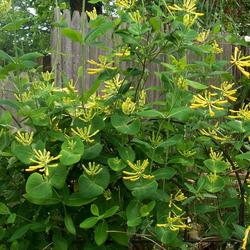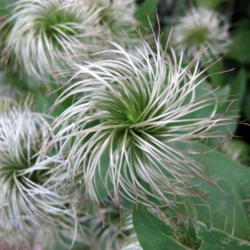There are several reasons you may want to consider vines as ground covers:
-Erosion control
-To choke out weeds
-As easy fillers for shady areas
-To cover areas where perennials may have died back for the year
-To help protect delicate plants that break easily in windy areas
-For beauty
If your intent is to use vines for erosion control or to choke out weeds, you’ll want to use a vine with heavy foliage. Be aware that the very traits that will make a vine desirable for this use may also be cause for alarm later because of its vigorous growth, especially in fertile soil. You’ll probably want to do some research to find a suitable vine for your zone before you go shopping. For example, honeysuckle and some types of ivy fit into this category, but also have very aggressive growth habits.

|
Areas of lawn or gardens under trees with a dense foliage canopy are usually challenging to plant under. Lesser Periwinkle (Vinca minor), also known as Creeping Myrtle, is a low creeper vine that does well in part to full shade. Once established it’s quite drought tolerant too. Japanese Spurge is another and isn’t vigorous or weedy looking.

|
Clematis are perfect vines for crawling through your perennial gardens, especially the integrifolia (herbaceous) clematis. They come with flowers in a wide range of colors, shapes and sizes, and aren’t considered aggressive. After the flowers die, beautiful seed heads appear for the remainder of the gardening season. Some of the integrifolias do tend to self-seed, which may be a good or bad thing depending on how much ground cover you want.

|
If you’d like to experiment without committing to a long-term ground cover vine, try an annual like the sweet potato vine (Ipomoea batatas). They come in several colors and various leaf forms.
The beauty of these ground cover vines is that in addition to just covering the ground, they can also climb up rocks, stumps, fences, etc. to add interest to your landscaping.
Ground cover vines can be easy to care for, but at least once a month you should check on them and perform maintenance as needed. The preferred method to control the faster growing ground cover vines is pruning. Maybe just redirecting a wayward vine or two is all that’s needed for the slower growing varieties. If you find you’ve planted one that’s too aggressive, it’s easier to remove it when it’s small. Once established, even a small piece of root left in the soil can re-grow. Also, make sure they aren’t planted in an area where they’ll grow into your neighbor’s yard.
Vines vary in size, color, texture and rate of growth, and you should be able to find one to fit your needs. It pays to do your homework so you’ll be happy with your choice for many years.
| Thread Title | Last Reply | Replies |
|---|---|---|
| Vines as groundcovers... by plantmanager | Jan 11, 2016 10:51 AM | 4 |
| Ground cover vines by CarolineScott | Sep 30, 2014 9:39 AM | 12 |